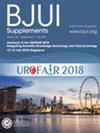订书机与完全手工缝制的机器人体内新膀胱:围手术期和功能结果
IF 3.7
2区 医学
Q1 UROLOGY & NEPHROLOGY
引用次数: 0
摘要
目的比较机器人辅助根治性膀胱切除术(RARC)中钉定(ST)和手缝(HS)体内原位新膀胱(iON)配置的围手术期、术后和功能结果。患者和方法:对单中心机构膀胱癌数据集进行“RARC”、“订书机”和“手缝”离子查询。收集2018年1月至2023年7月期间接受治疗的患者的基线、围期和术后特征。使用Kruskal-Wallis检验和卡方检验比较连续变量和分类变量。Kaplan-Meier法用于评估功能预后。采用Cox回归分析确定尿失禁恢复的预测因素。结果共纳入116例患者(HS - iON, 60例)。除了HS - iON组的住院时间较短外,围手术期结局无差异(P <;0.001)。术后30天(P = 0.17)和90天(P = 0.69)并发症无差异。HS - iON组结石发生率较低(P = 0.01)。Kaplan-Meier分析显示,HS - iON患者的day - (P <;0.001)和夜间(P <;0.001)控制恢复概率。在多变量分析中,尿失禁恢复的唯一独立预测因子是“性节约方法”。排除接受性保留手术的患者,HS方法是夜间尿失禁恢复的唯一预测因素(风险比2.6,95%置信区间1.27-5.34;P = 0.009)。结论手缝可能是RARC中离子配置的较好选择。ST‐iON没有被证明可以减少手术时间或围手术期并发症,但似乎对结石形成和失禁恢复的风险有显著影响。在肿瘤可行的情况下,应优先选择节约性生活的方法来改善白天和夜间的尿失禁恢复。本文章由计算机程序翻译,如有差异,请以英文原文为准。
Stapled vs totally handsewn robotic intracorporeal neobladder: perioperative and functional outcomes
ObjectivesTo compare perioperative, postoperative and functional outcomes between stapled (ST) and handsewn (HS) intracorporeal orthotopic neobladder (iON) configuration during robot‐assisted radical cystectomy (RARC).Patients and MethodsOur single centre institutional bladder cancer dataset was queried for ‘RARC’ ‘stapled’ and ‘handsewn’ iON. Baseline, peri‐ and postoperative features of patients treated between January 2018 and July 2023 were collected. Continuous and categorical variables were compared using Kruskal–Wallis and chi‐square tests. The Kaplan–Meier method was applied to assess functional outcomes. Cox regression analysis was performed to identify predictors of continence recovery.ResultsOverall, 116 patients were enrolled (HS‐iON, 60 patients). There were no differences in perioperative outcomes, except for the hospital length of stay, being shorter in the HS‐iON cohort (P < 0.001). There were no differences in the 30‐ (P = 0.17) and 90‐day (P = 0.69) postoperative complications. The stone rate was lower in the HS‐iON cohort (P = 0.01). At Kaplan–Meier analysis, patients with HS‐iON had higher day‐ (P < 0.001) and night‐time (P < 0.001) continence recovery probabilities. At multivariable analysis, the only independent predictor of continence recovery was ‘sex‐sparing approach’. Excluding patients who underwent sex‐sparing procedures, the HS approach was the only predictor of night‐time continence recovery (hazard ratio 2.6, 95% confidence 1.27–5.34; P = 0.009).ConclusionHand sewing may represent a preferable option for iON configuration during RARC. ST‐iON did not prove to either reduce operative times or perioperative complications, while seemed to significantly impact on the risk of stone formation and continence recovery. Whenever oncologically feasible, a sex‐sparing approach should be preferred to improve day‐ and night‐time continence recovery.
求助全文
通过发布文献求助,成功后即可免费获取论文全文。
去求助
来源期刊

BJU International
医学-泌尿学与肾脏学
CiteScore
9.10
自引率
4.40%
发文量
262
审稿时长
1 months
期刊介绍:
BJUI is one of the most highly respected medical journals in the world, with a truly international range of published papers and appeal. Every issue gives invaluable practical information in the form of original articles, reviews, comments, surgical education articles, and translational science articles in the field of urology. BJUI employs topical sections, and is in full colour, making it easier to browse or search for something specific.
 求助内容:
求助内容: 应助结果提醒方式:
应助结果提醒方式:


